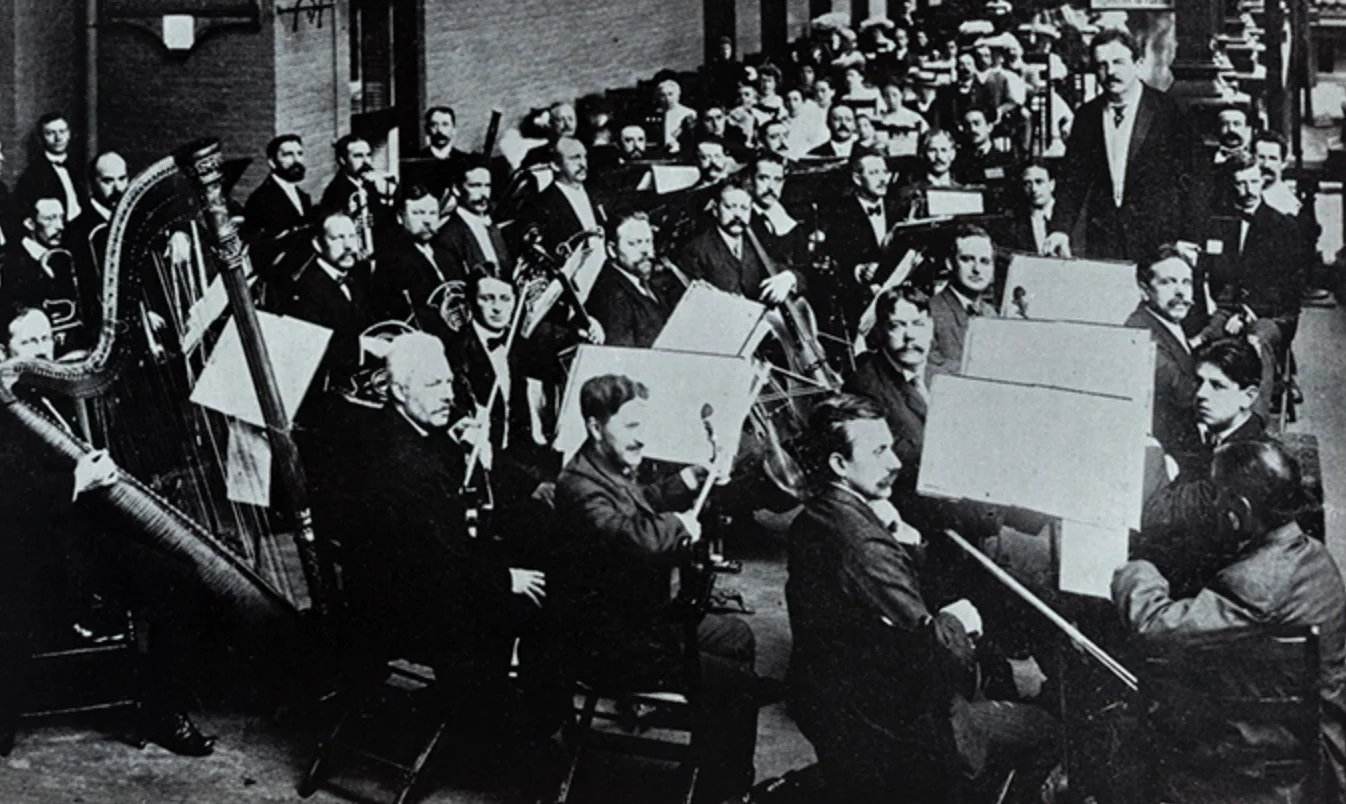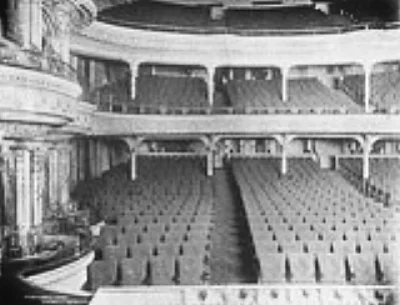Historical Performance
Anna Wheaton and chorus in Oh, Boy! (1917)
In reintroducing the repertoire of early American musical theatre to contemporary audiences, we seek to emulate the style of original performances to the fullest extent possible. We are governed by the philosophy of the historical performance movement. Chief among our aesthetic principles is the notion that the performance practice employed at the time of creation of any composition, to the extent that we can know it, must be our primary interpretive model. In applying this aesthetic to the repertoire of early American musical theatre, we believe it is essential to prioritize the use of both original materials and musical techniques, which include not only original orchestrations and period instruments, but also matters of phrasing and rhythmic freedom.
Central to this approach is the study of historical recordings as they are the most effective tools we have for recovering the performance practice of early American musical theatre. Period recordings allow contemporary listeners to hear the essential elements of the common practice of the late nineteenth and early twentieth centuries with respect to tempo, rhythm, articulation, and phrasing. Our performance practice is largely built upon the evidence we derive from these recordings, not unlike the way contemporary performances of Baroque music are largely based upon information learned from musical treatises and other sources from the period. Despite the limitations of period recording technologies—particularly with respect to acoustic audio fidelity, abbreviated length, and alteration of scoring—the existence of contemporary interpretations offers unprecedented access to the articulation, rhythm, and phrasing from original performance traditions.
While we seek to avoid copying specific performances, we are confident that applying performance practice ideas garnered from a broad variety of historical recordings yields a deeper understanding of the interpretive traditions that made the music of early American musical theatre so compelling and successful in its day. We believe our approach to this music parallels similar efforts by artists who pioneered historically informed interpretations of Baroque and Classical Era repertoire in recent decades. It is our conviction that the music of early Broadway deserves an historically informed approach no less rigorous than the music of J. S. Bach, Mozart, and other great masters of classical music.
Original Orchestrations
The use of original orchestrations is central to our mission to recover the interpretive styles of early American musical theatre. Crafted by master arrangers, these scores are integral to the music itself and put contemporary listeners in direct contact with the sound world of the late nineteenth and early twentieth centuries. These original orchestrations are as vital to the theatre music of Jerome Kern and Victor Herbert as are the orchestrations of operas by Mozart and Verdi.
Thousands of musical shows were produced in New York City since the earliest indigenous ballad operas of the 1760s. Each production featured orchestral music, either as pure instrumental pieces (i.e., overtures, entr’actes, exit music, etc.) or as accompaniment for singers, dancers, and a variety of other entertainers. Unfortunately, most of the original musical materials from these productions—primarily manuscript full scores and orchestral parts—were discarded when shows concluded their Broadway engagements and subsequent tours. Despite the routine destruction of these materials over the years, we are fortunate that many important orchestral scores have survived from early Broadway shows and are now being preserved in archives with the same curatorial care as are manuscripts from the classical tradition.
With the acquisition of the Victor Herbert Collection, the Jerome Kern Collection, the George and Ira Gershwin Collection, and the Tams-Witmark Music Library, the Library of Congress in Washington, D.C., has become the single largest repository of original manuscripts of music from the American musical theatre in the world. The Victor Herbert Collection contains full orchestral scores for all or part of no fewer than fifty theatrical productions staged on Broadway between 1894 and 1924. The Jerome Kern Collection—the majority of the orchestral scores therein coming from the astonishing discovery and rescue of a large body of vulnerable and neglected manuscripts at the Warner Bros. Music warehouse in Secaucus, N.J. in 1982—includes dozens of scores, many of them in original full-orchestral arrangements. The Tams-Witmark Music Library in New York City once contained the largest manuscript collection of orchestral scores of early Broadway show music in existence. Having subsequently acquired the Tams-Witmark collection of theatre music, the Library of Congress now houses the majority of this unique body of historical documents.
Score Preparation and Reconstruction
The preparation of performance scores and parts for our programs involve a labor-intensive process of transcribing and editing manuscript partituras (orchestration scores). Since most of these scores have rarely, if ever, been transcribed and performed since the shows were first produced, the creation of authoritative contemporary performance editions is a crucial preservation effort that will make the music widely available to musicians and audiences for the first time. We envision that Theatre Comique will advance the cause of preservation of this important tradition in American music by establishing a permanent musical library of scores and parts prepared with scholarly editorial practices.
The multitude of orchestral scores that have been destroyed over the years represent a body of music no less important to the legacy of Broadway and American music than that which we still possess in original orchestrations. It is therefore equally vital to the process of recovering our musical heritage that we reconstruct lost orchestral scores while we continue to perform original orchestrations. Reconstructing orchestral scores involves analysis and modeling of historical materials such as period recordings, piano-vocal scores, and related partituras to build working editions that replicate original orchestrations as closely as possible. Through the creation of scholarly reconstructions, we will ultimately make available the great preponderance of musical theatre repertoire that has not been preserved in orchestral versions. The recovery of lost scores will increase our capacity to present to the public as broad and balanced a representation of the music from the popular musical stage in America as possible.
Victor Herbert and orchestra, circa 1900
Period Instruments
It is now widely accepted that early music comes to life when performed on appropriate period instruments. We believe this to be true for music from all eras as the use of period instruments allows musicians the opportunity to recreate the original energy of the music. It is our goal to reproduce as much as possible the sound world of the original productions of early American musicals that its creators envisioned and experienced in the theatre. For example, whenever possible, string players in our orchestra will use gut strings employed at the time of the original performances. Brass players will use period instruments that have a narrower bore and softer attack. Likewise, woodwind instruments from the turn of the century provide an appropriate counterpart to the brass. Percussion instruments designed with less tension have a softer timbre and thus provide less intrusive ensemble support.
Instruments in every group had a softer sound and attack, allowing for a more flexible and lighter performance style than is possible on their modern counterparts. Performances of classical music from this period are marked by a discernible lightness as well as a natural rhythmic vitality and freedom not present in contemporary performances of the same repertoire utilizing modern instruments. We believe period instruments are essential to the recreation of this manner of performance, particularly with repertoire that was created for singing actors and comedians whose voices were not trained for the operatic stage in the way that has become standard for most classical singers nowadays.
Knickerbocker Theatre, New York City
Historical Venues and Unamplified Performance
Studio for the Early American Musical is committed to performing early American musical theatre without amplification. Taking our name from a commonplace moniker for American variety theatres that housed this country’s indigenous musical art form during the late nineteenth and early twentieth century, we align ourselves not only with the mission of recovering the music from this period, but also with the goal of rediscovering American musical theatre as an acoustic phenomenon. Musical-theatre productions on Broadway were uniformly staged without amplification until 1960. By staging performances in historical spaces in conjunction with the use of period instruments, Studio for the Early American Musical will provide audiences with rare opportunities to hear this repertoire in the most accurate acoustical setting possible. Preserving this theatrical tradition is essential to giving audiences the opportunity to experience the thrill and enchantment of being in the presence of outstanding singers and instrumentalists performing live on stage. Almost all current revivals and contemporary performances of American musical theatre utilize amplification. But since amplification distorts the quality, volume, and direction of sound from the stage, we intend to restore the performance tradition of acoustic musical theatre in order to realign the genre with the classical operatic and theatrical traditions from which it came.




